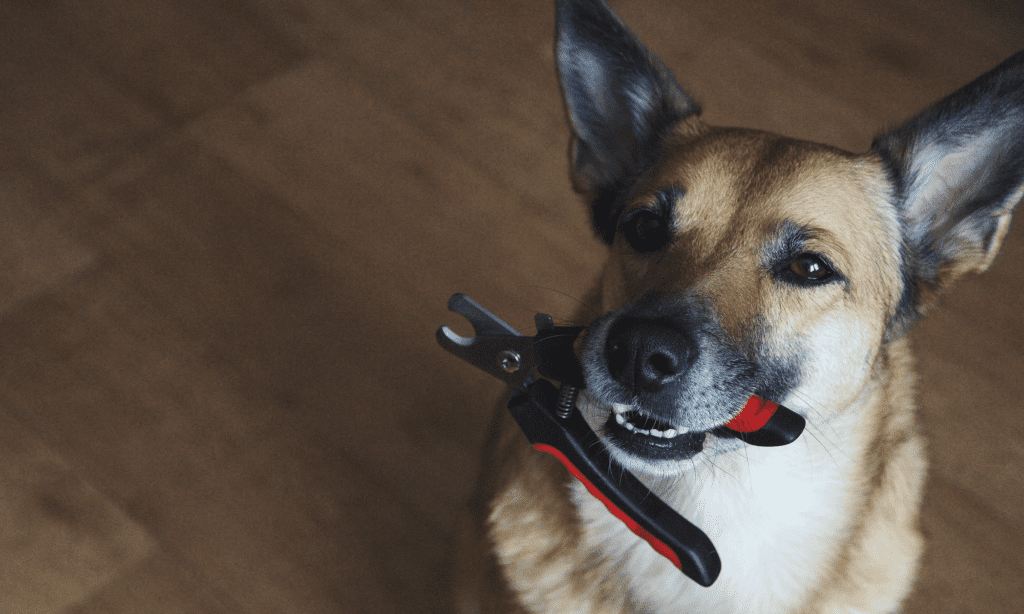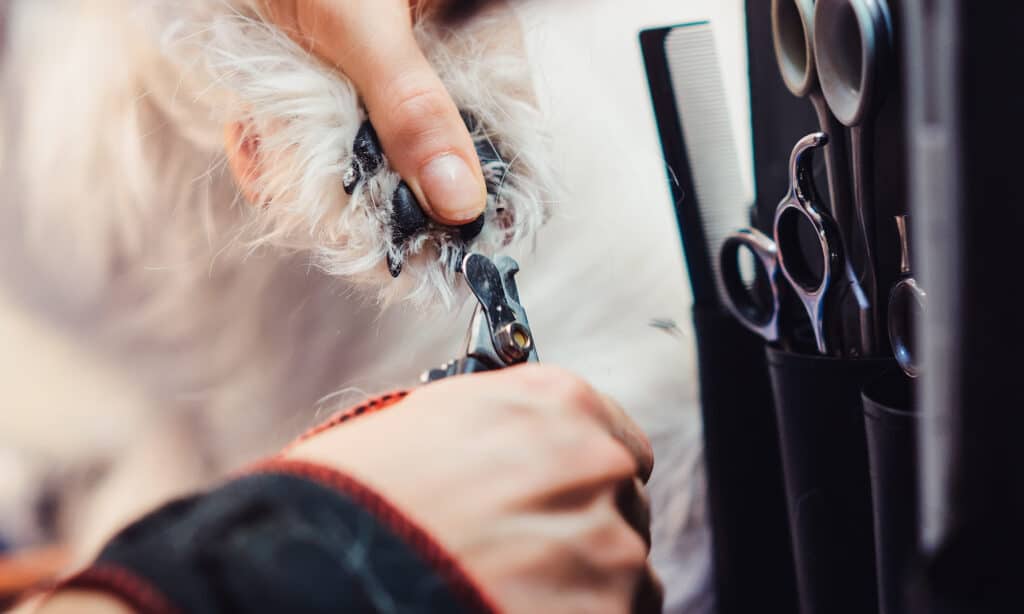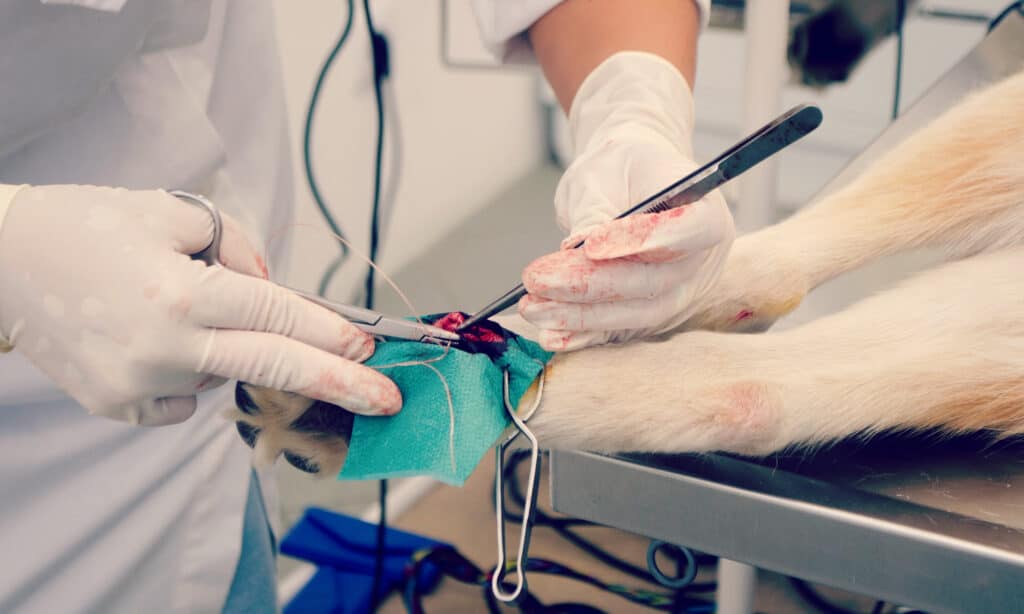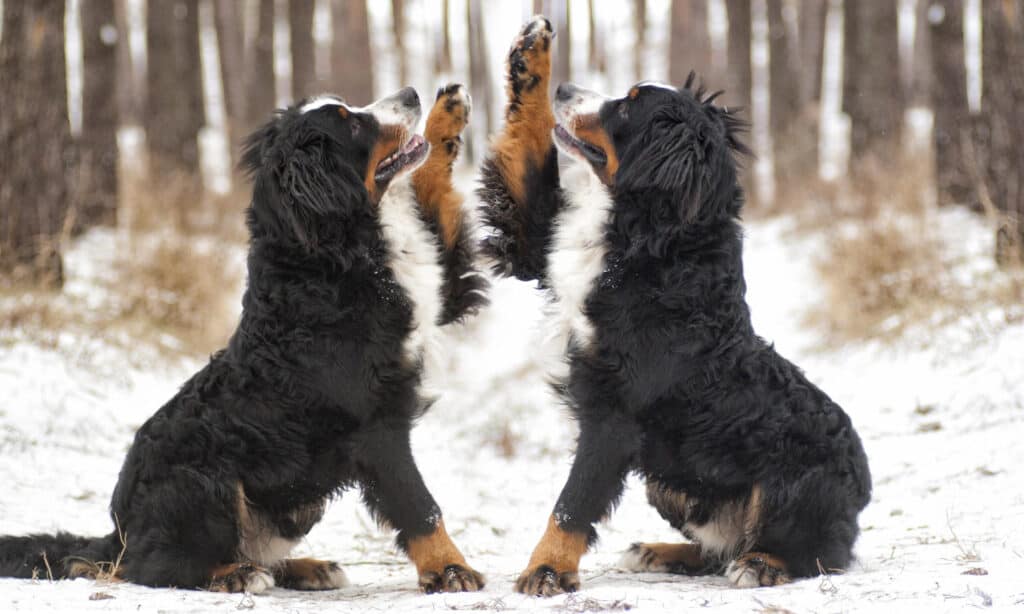As a dog owner, it’s easy to overlook the little things, like your furry friend’s dew claws. But did you know that overgrown dew claws can cause a myriad of problems for your pup? In this comprehensive guide, we’ll delve into everything you need to know about overgrown dew claws in dogs. Whether you’re new to the world of dog parenting or a seasoned pro, this blog post offers invaluable information to help you keep your beloved canine pal happy, healthy, and safe. So, let’s jump in and get the lowdown on dew claws!

What are Dew Claws?
Dew claws are the small, often overlooked nails. They are located on the inner side of a dog’s paw, slightly higher up than the other nails. They are equivalent to a human’s thumb. While they might not seem as functional as the other nails, they do serve a purpose.
Dew claws are vestigial digits that, in some cases, can be useful for dogs during various activities. They may help dogs gain better traction and stability when running or climbing, and they can also assist in holding objects like bones or toys while chewing. Some breeds even have double dew claws, such as the Great Pyrenees and Briard, which are considered a breed standard.
In many dogs, however, the dew claws don’t touch the ground. Therefore, they don’t naturally wear down like the other nails. As a result, they can easily become overgrown if not properly maintained. It’s essential for dog owners to understand the importance of dew claws. Owners must ensure they are adequately cared for to prevent potential issues.
Causes of Overgrown Dew Claws
Overgrown dew claws in dogs can result from various factors. These can range from a lack of regular maintenance to certain medical conditions. Here are some of the primary causes:
- Lack of regular trimming: Since dew claws usually don’t touch the ground, they don’t experience the natural wear and tear that helps keep other nails at a healthy length. If not trimmed regularly, dew claws can grow excessively long, leading to potential issues.
- Inactivity or limited exercise: Dogs that are predominantly inactive or have limited opportunities for exercise may not experience enough friction on their nails to wear them down naturally. This can contribute to the overgrowth of dew claws. Particularly in dogs with already minimal contact between their dew claws and the ground.
- Age and breed factors: Some dog breeds are more susceptible to overgrown dew claws due to their genetics. For example, the breeds with double dew claws. Additionally, older dogs may be more prone to overgrown nails as their activity levels decrease with age.
- Medical conditions: Certain medical conditions, such as hypothyroidism or other hormonal imbalances, can lead to abnormal nail growth, including overgrown dew claws. In these cases, addressing the underlying condition is essential for managing the overgrowth.
Understanding the cause of your dog’s overgrown dew claws is crucial for determining the appropriate course of action. Regularly monitoring your dog’s dew claws and addressing any signs of overgrowth can help prevent complications and keep your furry friend happy and pain-free.

Dangers and Risks of Overgrown Dew Claws
Overgrown dew claws in dogs can pose several dangers and risks. Here are some of the potential issues associated with overgrown dew claws:
- Pain and discomfort: When dew claws become excessively long, they can cause significant discomfort and pain for your dog. Overgrown nails can press into the paw pad or curl around and grow into the skin. This can lead to constant pressure and irritation.
- Infection and inflammation: As overgrown dew claws press into the skin or paw pad, they can create open wounds or sores. These injuries are susceptible to bacterial infections, which can cause inflammation, redness, and pus discharge. If left untreated, the infection can spread and become more severe, potentially requiring medical intervention.
- Ingrown nails: In some cases, overgrown dew claws can curl inward and grow into the skin, resulting in ingrown nails. Ingrown nails are painful and can lead to inflammation, infection, and even abscesses if not addressed promptly.
- Mobility issues: Overgrown dew claws can make it difficult and painful for your dog to walk or run, affecting their overall mobility. This can lead to a decrease in their activity levels and can negatively impact their physical and mental wellbeing.
- Risk of injury during play or exercise: Overgrown dew claws are more prone to snagging on objects like carpets, furniture, or outdoor obstacles. This can lead to painful tears or even complete avulsion of the nail. This kind of injury can be extremely painful for your dog and may require veterinary attention.
By understanding the dangers and risks of overgrown dew claws, you can better appreciate the importance of proper nail maintenance and care for your canine friend. Regularly monitoring and addressing any overgrowth can help prevent these complications.
Signs of Overgrown Dew Claws
Recognizing the signs of overgrown dew claws is crucial for addressing the issue promptly and preventing potential complications. Here are some indicators that your dog’s dew claws may be overgrown:
- Visual cues: The most apparent sign of overgrown dew claws is their excessive length. If the dew claw is noticeably longer than the other nails or has started to curl, it’s time for a trim. Additionally, check for any redness, swelling, or discharge around the dew claw. These can indicate an infection or ingrown nail.
- Behavioral changes: Dogs experiencing discomfort or pain from overgrown dew claws may exhibit changes in their behavior. They might be more hesitant to walk or run, limping, or favoring one paw over the other. In some cases, dogs might excessively lick or chew at their dew claws. This can further exacerbate the issue and increase the risk of infection.
- Audible signs: If you notice a clicking or tapping sound when your dog walks on hard surfaces, it could be a sign that their nails, including the dew claws, are too long. While the dew claws typically don’t make contact with the ground, severely overgrown dew claws might touch the floor and produce a sound.
By keeping an eye out for these signs, you can catch overgrown dew claws early and take the necessary steps to address the issue. Regularly check your dog’s paws and nails. Especially if they are prone to overgrowth. This can help ensure their overall comfort and prevent potential problems.

How to Trim Overgrown Dew Claws
Trimming overgrown dew claws is essential to ensure your dog’s comfort and prevent potential complications. Here’s a step-by-step guide on how to trim overgrown dew claws safely and effectively:
Preparing for the Trimming Session
- Gather the necessary tools: You’ll need a pair of dog nail clippers (either guillotine-style or scissor-style, depending on your preference). I also recommend styptic powder or a styptic pencil to stop bleeding if you accidentally cut the quick.
- Calm your dog and ensure their comfort: Choose a quiet, well-lit area for the trimming session. Also, make sure your dog is relaxed and comfortable. You may want to have treats on hand to reward your dog for their cooperation.
Step-by-Step Process of Trimming
- Identify the quick: The quick is the blood vessel and nerve that run through your dog’s nail. Avoid cutting the quick, as this can cause pain and bleeding. In dogs with light-colored nails, the quick is usually visible as a pinkish area within the nail. For dogs with dark-colored nails, it can be more challenging to identify. It’s best to trim a little at a time and look for a dark circle in the center of the nail, which indicates you’re getting close to the quick.
- Proper trimming technique: Hold your dog’s paw gently but firmly and isolate the dew claw. Position the nail clippers at a 45-degree angle, with the cutting edge facing away from the paw pad. Trim the nail in small increments, starting from the tip and working your way towards the quick. If your dog’s dew claw is severely overgrown and curled, you may need to make multiple cuts to shorten the nail gradually. Stop trimming when you see the dark circle in the center of the nail or, for light-colored nails, when you’re about 2 millimeters away from the quick.
- Post-trimming care: If you accidentally cut the quick and your dog’s nail starts bleeding, apply styptic powder or use a styptic pencil to stop the bleeding. Praise and reward your dog with treats to create a positive association with the trimming process.
When to Seek Professional Help
- If you’re uncomfortable or unsure about trimming your dog’s overgrown dew claws, it’s best to consult a professional groomer or your veterinarian. They can safely and effectively trim the nails and provide guidance on proper maintenance and care.
Preventative Measures
Taking preventative measures is crucial in avoiding overgrown dew claws and maintaining your dog’s overall paw health. Here are some steps you can take to prevent overgrowth and keep your dog’s dew claws in good condition:
- Regular grooming and maintenance: Establish a routine for trimming your dog’s nails, including the dew claws, every 3-4 weeks, or as needed depending on your dog’s activity level and nail growth rate. Regular grooming helps ensure the nails remain at a healthy length and minimizes the risk of overgrowth and associated complications.
- Providing proper exercise: Regular exercise not only keeps your dog healthy and happy but also helps wear down their nails naturally. Activities like walking or running on pavement or other abrasive surfaces can help maintain your dog’s nail length. However, keep in mind that dew claws often have minimal contact with the ground, so you’ll still need to monitor and trim them as needed.
- Monitoring for changes: Regularly inspect your dog’s paws and nails for any signs of overgrowth, inflammation, or infection. If you notice any issues, address them promptly by trimming the nails or seeking veterinary advice if necessary. Early intervention can help prevent more severe problems from developing.
- Consulting with a professional: If you’re unsure about how to care for your dog’s dew claws or have concerns about their nail health, consult with a professional groomer or veterinarian. They can offer guidance on proper maintenance, trimming techniques, and frequency to keep your dog’s nails healthy.
By taking these preventative measures, you can effectively manage your dog’s dew claw health and prevent overgrown nails from becoming a problem. Regular maintenance and care can ensure your furry baby’s comfort and overall well-being.

Dew Claw Removal
Dew claw removal, also known as onychectomy, is a surgical procedure that entails the complete removal of a dog’s dew claws. While it’s not necessary for every dog, there are situations where removal may be recommended. Here’s what you need to know:
Situations where removal may be necessary:
- Recurring injuries: If your dog frequently experiences painful injuries or infections related to their dew claws, your veterinarian may recommend removal as a long-term solution.
- Malformation: In cases where the dew claw is malformed or not properly attached to the paw, removal may be necessary to prevent complications and discomfort.
- Breed standards: Some breeders may opt to remove dew claws in breeds where it’s considered a standard practice. However, this is becoming less common as attitudes towards cosmetic procedures for pets evolve.
Pros and Cons of Dew Claw Removal
Pros
Reduced risk of injury: Removing the dew claws can eliminate the risk of injuries, infections, and other issues related to overgrown or problematic dew claws.
Lower maintenance: Without dew claws, you won’t need to worry about regular trimming and monitoring for overgrowth.
Cons
Surgical risks: As with any surgery, dew claw removal carries inherent risks, such as anesthesia complications, infection, and post-surgery pain.
Recovery time: Your dog will need time to recover from the procedure, which may involve wearing an e-collar and restricting their activity for a period of time.
Ethical considerations: Some pet owners and professionals argue that removing dew claws for cosmetic reasons or convenience is unnecessary and unethical, as it may cause pain and discomfort to the animal.
Process of Removal and Recovery:
Removal: Dew claw removal is usually performed under general anesthesia or sedation. The veterinarian will make an incision around the base of the dew claw, remove the nail and surrounding tissue, and close the incision with sutures or surgical glue.
Recovery: After the procedure, your dog will need to wear an e-collar to prevent them from licking or chewing at the surgical site. Your veterinarian will provide you with instructions for post-operative care, including wound cleaning, pain management, and activity restrictions. The recovery period usually lasts 1-2 weeks, depending on your dog’s age, overall health, and how well they heal.
Before choosing dew claw removal, weigh the pros and cons and discuss the procedure with your veterinarian. They can help determine if it’s the best option for your dog and guide you through the process to ensure a successful outcome and recovery.

Conclusion
Dew claws might be small and often overlooked, but they play a significant role in your dog’s overall health. Recognizing the signs and taking appropriate preventative measures are key to ensuring your dog’s comfort and preventing potential complications. Through regular trimming, monitoring changes, or seeking professional advice, being proactive about your dog’s dew claw care is essential. By staying informed and aware, you can ensure your furry friend remains happy, healthy, and free from the dangers associated with overgrown dew claws. So, take charge of your dog’s paw health today, and let them put their best foot forward with confidence!
~Lindsie
